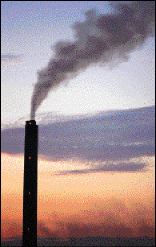Raman Spectroscopy Could Simplify Pollution Monitoring
Kathleen G. TattersonCOLUMBIA, Mo. -- Power plants must continuously track the amount of carbon monoxide, sulfur dioxide and nitric oxide that emit from their smokestacks. There usually is a separate detection system for each pollutant, but research at the University of Missouri-Columbia suggests that one Raman spectroscopy system could do the entire job.
Joseph Wehrmeyer, now a research associate professor at Vanderbilt University in Nashville, Tenn., worked with graduate student Praveen C. Kumar to develop instrumentation that can help companies comply with the US Clean Air Act Amendments. These regulations assess heavy fines on manufacturers who do not accurately and regularly monitor their emissions, so instrument reliability is a must. He said that not only would a single detection system simplify monitoring, but it could do it a lot cheaper.

Coal-burning power plants looking to keep simpler, more reliable records of the pollutants they emit could find the answer in continuous emissions monitoring systems based on Raman spectroscopy. |
In the University of Missouri-Columbia experiments, the research team excited gases using a Continuum Surelite II frequency-doubled Q-switched Nd:YAG laser. The detection system comprised a Princeton Instruments liquid-nitrogen-cooled, unintensified charge-coupled device connected to a Chromex 0.25-m imaging spectrograph. The team detected sulfur dioxide, carbon monoxide and nitric oxide down to 100 ppm, 250 ppm and 250 ppm, respectively.
Wehrmeyer said the system's sulfur dioxide sensitivity is suitable for coal-burning power plants, but today's electrical sensors are more sensitive to the other pollutants than this system is. "We need to get the nitric oxide detectability limit down by an order of magnitude to make it commercially viable," he said.
Researchers must also address cross-sensitivity of pollutants; e.g., when the laser hits a nitric oxide sample, it can create nitrogen dioxide, which the system detects as background noise. Wehrmeyer suggested that a longer wavelength and a thinner entrance slit might work better.
The report on the work, sponsored by St. Louis-based Union Electric Co., appeared in a recent issue of Applied Spectroscopy.
LATEST NEWS
- Fraunhofer CAP Appoints Head, Scientific Director: People in the News: 1/15/25 Jan 15, 2025
- Bioluminescent Tags Track RNA Dynamics in Live Cells in Real Time Jan 15, 2025
- Sensing and Inspection Specialist EVK Joins Headwall Group Jan 14, 2025
- PHOTON IP Raises $4.9M Seed Round Jan 14, 2025
- Graphene Prevents Damage to Flexible Thin Films for Wearable Electronics Jan 14, 2025
- Thorlabs Acquires VCSEL Developer, Longtime Partner Praevium Research Jan 13, 2025
- Electrically-Pumped GaAs-Based Nano-Ridge Lasers Fabricated at Wafer Scale Jan 13, 2025
- Photoactivated Gel Achieves Bone Regeneration and Adhesion at Same Time Jan 13, 2025
